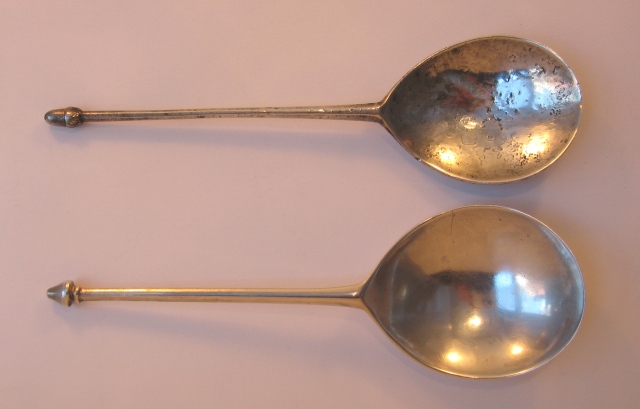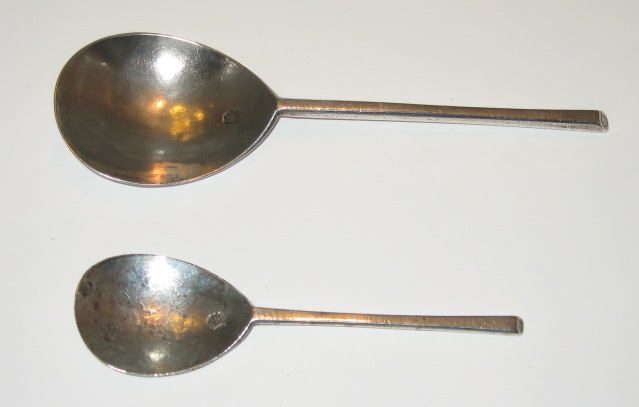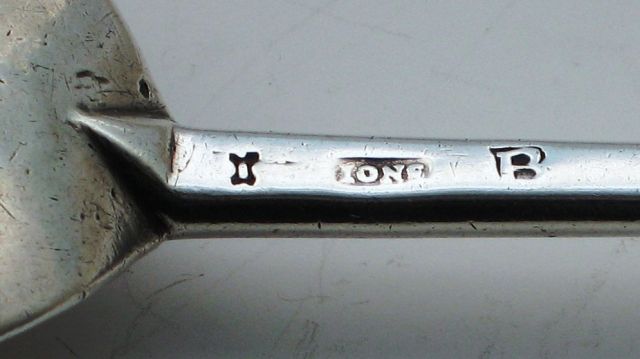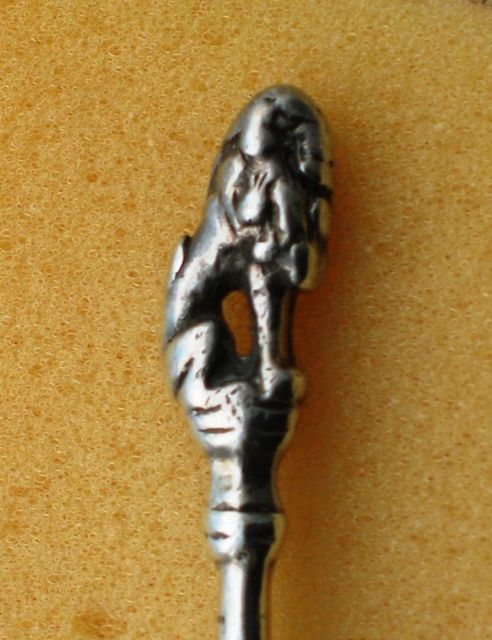|
|
In this Forum we discuss the silver of the United Kingdom, as well as British Colonial silver and Old Sheffield Plate. Past British - Irish Sterling topics/threads worth a look. |
|
|
| How to Post Photos | Want to be a Moderator? |
|
|
In this Forum we discuss the silver of the United Kingdom, as well as British Colonial silver and Old Sheffield Plate. Past British - Irish Sterling topics/threads worth a look. |
|
|
| How to Post Photos | Want to be a Moderator? |

|
 SMP Silver Salon Forums SMP Silver Salon Forums
  British / Irish Sterling British / Irish Sterling
  Early English Spoons Early English Spoons
|
| next newest topic | next oldest topic |
| Author | Topic: Early English Spoons |
|
agphile Posts: 798 |
  
 At the risk of boring you all with my personal enthusiasms I thought I would share some examples of early English spoons. Somewhere around the 13th century English spoons acquired a distinctive form, the main difference from spoons made on the continent being that English stems have a hexagonal cross-section. The spoon with an acorn finial at the top of the picture can be dated reasonably confidently to the early 14th century on the basis of its form: in particular, the top and bottom facets of the stem are much narrower than on later spoons. The second spoon with a diamond point finial is a bit of a puzzle to me. The top and bottom facets are even narrower (and not too clearly distinguishable in my photo, I fear).In fact, the stem appears to be transitional between a diamond-shaped and a hexagonal cross-section. This would suggest the spoon is earlier still. However, I suppose it could have been made with a diamond cross-section, the apparent top and bottom facets the result of wear and polishing over the years. If so, it is more likely to be a 15th century continental spoon and a cuckoo in my nest of early English spoons. I like to cling to the hope that it is, however, English and 14th century or even earlier. Neither spoon carries any maker's or town mark which is quite normal at this period. After these two spoons there is quite a gap in my collection until the late 16th century. The spoons to plug the gap are relatively uncommon and so far none has come up for sale at a price I am prepared to pay. To illustrate what I mean about the wider facets on the stems of later spoons I therefore have to jump to a maidenhead spoon by William Cawdell, London 1592. This widening may be linked to making room for hallmarks. IP: Logged |
|
swarter Moderator Posts: 2920 |
  
quote: Never boring. Thanks for the posting. IP: Logged |
|
ahwt Posts: 2377 |
  
Thanks for showing us these interesting and beautiful spoons. Those are the type that I rarely get to see. IP: Logged |
|
FredZ Posts: 1070 |
  
The study of spoon forms and their evolution is fascinating to me and so I delight in posts like these. These are great early spoons and were usually forged from a single blank. the tops were usually cast and soldered onto the forged handle. Thanks for sharing these and feel free to share more. Fred IP: Logged |
|
Polly Posts: 1971 |
  
Not boring in the least! I love that acorn finial. How big are these spoons? IP: Logged |
|
agphile Posts: 798 |
  
Sorry not to have been quicker to acknowledge and say thank you for the kind words. In reply to specific questions/comments: Polly: The diamond and acorn top spoons are both 6.1 inches long. The maidenhead is 6.4 inches. FredZ: Early diamond point and acorn top spoons were actually made in one piece. The separate casting of the finial started when other forms of finial appeared. I’m afraid the picture of my maidenhead spoon, copied from my catalogue, came out rather small. However, I think you can still see the solder mark on the stem just below the back of the maiden’s head in the relevant detailed view. I’ve taken another picture of the maidenhead, not very successfully I fear, alongside a child size so-called “Moor’s Head” by Daniel Carey, London, 1620, as a start to showing more examples of early spoons. It doesn’t take much to get me going. Actually, the ”moor’s” head is that of a child, probably meant as the infant Jesus, appropriately enough for a child’s spoon. After the acorn and diamond fell out of fashion the most common finial was the seal top in one form or another. My picture shows three examples. From top to bottom: provincial, late 16th century, maker HW (unidentified); late 16th century, Gladstone and Utting, Lichfield; circa 1619 (date pricked on seal), unknown maker, Beccles. They are respectively 6.5, 6.4 and 7.2 inches long. The Beccles spoon has had the misfortune to pass through the collection of the Marquess of Breadalbane. He had the regrettable habit of stamping his name on the stems of his spoons. I think it doubtful that the benefit of the provenance outweighs this vandalism a hundred or so years ago – his collection was sold at Christie’s in 1926. Incidentally, the last picture again reveals the solder line where the finial was spliced to the stem. Wear over the centuries can make this more apparent than it would have been when the spoon was new. I think that exhausts me, and perhaps any readers, for a single post. IP: Logged |
|
swarter Moderator Posts: 2920 |
  
quote: Doesn't exhaust me - keep them coming! Lord Bredalbane didn't stamp his name on every spoon he owned - here is an example (posted 7 years ago - how time flies) of one bearing only his crest (One that didn't get away). IP: Logged |
|
agphile Posts: 798 |
  
Swarter: I wonder whether Breadalbane reserved his crest for the household silver while reserving the name stamp for his collection perhaps? If I seem hesitant about coming back with more and more spoons, it is partly because I have known eyes to glaze over when I wax too enthusiastic about them and partly because even those who do not collect these early spoons may well have better pictures of better examples in their reference books. I have tended to gather examples of the various finials rather than concentrate on makers or towns of origin and, apart from the moor’s or child’s head I have already illustrated, don’t own any of the rarer ones. However, this spoon is less common if not actually rare. The finial is unique to this area of the South West. It seems to have derived from an earlier and rarer final of a naked female, generally referred to as Aphrodite. The combination of rarity and nudity makes the latter command higher prices than I am willing to pay so, sadly, I cannot provide a picture. IP: Logged |
|
agphile Posts: 798 |
  
 Of course, you did not have to have a finial. The slip top was a common pattern. The name derives from contemporary inventory entries as “slipped in the stalk”, i.e. cut across the stem. The table spoon here is by Daniel Carey, London, 1615, and the child size spoon by Edward Hole, London, 1631. Reverting to FredZ’s point about hand forging, it was an interesting development. Roman spoons were cast and finished by scraping. As far as I can judge from the very few surviving examples, Saxon spoons were also cast but the bowls then hammered into shape. The Saxon and early Norman spoons have grotesque animal decoration on their stems. Did hand forging of the whole spoon begin when the stem became plainer, I wonder. Or was it a question of spoonmaking being reinvented as the demand for domestic silver grew and silver spoons were not restricted to the Saxon or Norman elite? IP: Logged |
|
agphile Posts: 798 |
  
Back to finials. I am quite fond of the Lion Sejant. Here are a couple of examples by William Cawdell, London, 1610, and IS or SI, provincial and possibly a bit earlier. It is difficult to recognize the lion in the head on view, partly because the forelegs are hidden by a shield. You would have thought this was the obvious place to engrave a crest or initials but I have only seen this once, on a rare full set of lion sejant spoons. Some lions, particularly on earlier spoons, are modeled without the shield but an example remains on my wish list. IP: Logged |
|
Polly Posts: 1971 |
  
Agphile, I think there's zero chance of you boring anyone here with. Thank you for this fascinating glimpse of your lovely collection. IP: Logged |
|
agphile Posts: 798 |
  
Thank you, Polly. I suppose I shouldn’t leave the topic of early spoons without at least touching on Apostle Spoons. When my collecting interests started to move back in time I firmly resolved not to get into Apostle Spoons. I didn’t want to find I was trying to get an example of every Apostle and anyhow I was more attracted by the simpler finials. For example, I really like most of the spoons I have already shown, but I find the female “Buddha” interesting and amusing rather than beautiful. Anyhow, the result of this firm resolve is that I do actually have a couple of Apostle Spoons. The top spoon is marked AB conjoined. This unidentified maker has been placed in the Salisbury area. Stylistically I would have dated the spoon to the late 16th century but the experts seem to think AB was a 17th century maker so maybe I should settle for early 17th century (unless there were two generations of AB). The lower spoon, also provincial and circa 1630, has an unattributed fleur-de-lys mark. Apostle finials were typically cast in three parts: the figure itself, its nimbus (halo) and a symbol to identify the Apostle. The top spoon has lost its symbol and the lower spoon never had one – it was left off some 17th century finials, allowing the Apostle to be whichever you wanted. The top apostle is a pretty crude casting, perhaps from a very worn model, but the nimbus is reasonably sharp. This rayed nimbus is one of the reasons I was tempted to give the spoon an earlier date though the main factor was the form of the spoon. Note the difference in bowl shape between the two spoons for example, but I suppose some makers could persevere longer with old fashioned forms. The second spoon has a Holy Dove nimbus. In the 16th century this nimbus tended to be reserved for the Master (Christ) finials but by the 17th century it was commonly used for all the Apostles. The finials on these spoons were generally gilded, as often was the whole spoon. Traces of the gilding remain but these two examples have been spared the re-gilding that often occurs. By the middle of the 17th century a new, flat-stemmed pattern, the Puritan, was replacing these early spoons with their hexagonal stems, but that is another story. IP: Logged |
|
agphile Posts: 798 |
  
I am returning to this thread because my last post left me feeling that maybe I ought to have an example of an apostle complete with emblem to identify him. It didn’t take long for this feeling to overcome, yet again, my resolve to steer clear of apostles. I now have a St Peter with his key. By John Quick, Barnstaple, circa 1620 (for the marks used by the Quick workshop see Tim Kent’s “Barnstaple Silver and its Makers”). As you see, it has another variation on the nimbus/halo and has survived approaching 400 years in reasonable condition even if his facial features now look a little odd. Anyhow, I am enjoying this latest acquisition and felt it was worth sharing. IP: Logged |
|
swarter Moderator Posts: 2920 |
  
Photographers suffer from LBA (lens buying addiction); I'm afraid you are afflicted with SBA (spoon buying addiction).. As we say on this side of the pond, "Don't feel like the Lone Ranger", meaning you have lot of company.  Seriously, though, congratulations on a rare find, and thanks for posting it. IP: Logged |
|
FredZ Posts: 1070 |
  
I never tire of seeing images of early spoons. Images like these introduced me to spoon making at an early age and I got hooked. Keep the images and history coming! Fred IP: Logged |
|
dragonflywink Posts: 993 |
  
This is a fascinating thread, it would make a wonderful slide-show..... ~Cheryl IP: Logged |
|
Scott Martin Forum Master Posts: 11573 |
  
I agree. agphile, If you are up to providing the image & text then I will do the back office slide show stuff. What about it? IP: Logged |
|
agphile Posts: 798 |
  
Scott I could have a go if you are sure. It would just be one person's collection rather than a comprehensive overview and would be light on the rarest or best examples. My skills as a photographer are pretty erratic. Will the sort of pictures I have been showing in this thread be adequate? And would I need to work out how to do it in powerpoint, or would a text in Word 2007 plus separate pictures be OK? David IP: Logged |
|
Scott Martin Forum Master Posts: 11573 |
  
David, Great! quote: That would be perfect. It will become another presentation in:
It seems as if there is a collector for everything. It takes a collectors view to discover the unique, interesting, bizarre and fascinating aspects of everyday objects.
quote: They’ll be fine. Not to worry. quote: Also perfect. IP: Logged |
|
Scott Martin Forum Master Posts: 11573 |
  
Everyone, Just to let you know there is a first draft of a presentation. The the second draft is in the works. agphile and I have our distractions... but it is coming along. IP: Logged |
|
ahwt Posts: 2377 |
  
I am looking forward to seeing it. Agphile you have a wonderful collection. [This message has been edited by ahwt (edited 08-08-2010).] IP: Logged |
|
Scott Martin Forum Master Posts: 11573 |
  
The slide show has been finished. Thank you agphile. IP: Logged |
|
dragonflywink Posts: 993 |
  
Great collection, thanks so much for sharing! ~Cheryl IP: Logged |
|
vathek Posts: 966 |
  
I've always found these spoons fascinating, so thanks for the post of this topic. IP: Logged |
|
bascall Posts: 1629 |
  
Great collection; what a treat! These old eyes would like to see the images a little larger, but the items are so interesting that the size is not a complete distraction. IP: Logged |
|
Scott Martin Forum Master Posts: 11573 |
  
Bascall, If you are using Firefox as your browser, please note you may zoom in on the images (larger or smaller) just by holding down the CTRL key and scrolling the wheel on your mouse. If you don't have a wheel mouse: IP: Logged |
|
swarter Moderator Posts: 2920 |
  
The slide show is a marvelous succinct summary of the evolution the English spoons, and well illustrated. Many thanks for the excellent presentation. [This message has been edited by swarter (edited 08-16-2010).] IP: Logged |
|
agphile Posts: 798 |
  
Thanks all for the kind words. My thanks in turn to Scott for his editing and his patience. With regard to Bascall's point, I did wonder about restricting each slide to a single spoon. This would have allowed a larger image of the spoon but made comparisons more difficult. I guess it would be possible to re-work the slide show or to add further slides with single images of particular spoons if there was a general feeling that this would be helpful though, as Scott has said, it should be possible to zoom in and magnify the existing images. David IP: Logged |
|
ahwt Posts: 2377 |
  
My thanks for a wonderful slide show. The presentation is just right. IP: Logged |
|
doc Posts: 730 |
  
I echo the compliments-really great and very informative. I particularly like the hoof spoon; I have never seen an example of one before. IP: Logged |
|
Scott Martin Forum Master Posts: 11573 |
  
Anyone else care to do a Collector's Corner, Collector's View slide show as well? If Yes, please start a new thread in the most appropriate associated forum. Thanks, IP: Logged |
|
agphile Posts: 798 |
  
A bit of disappointing news about the Early English Spoons slide show. I have come to the conclusion that one of the spoons I illustrated (a 1631 Puritan) is in fact a forgery. I bought it quite a while ago when I was perhaps not quite alert enough to the “too good to be true” rule. I have re-assessed it, following consultation with others, after a similar spoon with identical marks came to my notice. It would seem both spoons are fakes. There may be further examples around so I am inclined to keep the spoon in the slide show as a dreadful warning. Scott: How easy would it be to change the text of Slide 14 to take account of this? I would suggest the following as the new text:
As can be seen, the date letter is again at the top of the stems because the spoons have no finial. The three examples here are, from top to bottom: • Jeremy Johnston, London, 1661, 7.4 inches I should have realized that the 1631 spoon was “too good to be true” when I bought it years ago. A 1632 fork in the Victoria and Albert Museum is the earliest genuine example of the Puritan form that I have actually seen. The hazards for the collector of early spoons include complete forgeries like the example here, later spoons that have been re-shaped and genuine early spoons that have been “improved” by the addition of a new finial, typically converting a seal top to a potentially more valuable Apostle spoon.” On a more cheerful note, I have acquired just a few more early spoons which I don’t believe to be fakes. I might share them in a separate post. IP: Logged |
|
Scott Martin Forum Master Posts: 11573 |
  
quote: That would be great. I made the requested changes to slide 14. IP: Logged |
|
agphile Posts: 798 |
  
Thanks Scott There have been just four additions to my group of early spoons over the last couple of years, adding examples of different finials or stem shape. Here they are in date order. Baluster Knop, Francis Jackson, London 1560. This is a rare finial found on mid 16th century London spoons and, in a slightly different form, on later Barnstaple spoons. This spoon has been re-gilded and had a later crest (for Fitzgibbon, I think) engraved in the bowl. In more nearly original condition it would certainly have cost more than I would have been prepared to pay. Hexagonal Seal Top, unidentified maker, London 1576. Most seal tops are crowned by a round “seal”. The hexagonal version is rarer. Its origin lies in the earliest versions before the finial was cast separately and soldered to the spoon. A very simple seal top would be shaped to follow the hexagonal cross-section of the spoon’s stem. Some separately cast seal tops, as here, continued in this tradition. Hexagonal Seal Top by AB, Salisbury area, early 17th century. A later example with a more modest, but attractive, finial. Stump Top, London, c. 1630. This is another rare form. The marks on this example are too worn to identify the maker or be confident of the date – I think it might be 1632 from what remains of the date letter. The top of a stump top’s stem takes the form of a pyramid or dome rather than the slanted cut-off of a slip top spoon. They have an octagonal cross-section to the stem rather than the normal English hexagonal stem. The wear on this example makes the cross-section look a bit more like a square with rounded corners. Despite the wear, which made it affordable, this is perhaps my favorite among the recent acquisitions. I like the simple shape and am a little surprised that it doesn’t seem to have been as popular as the slip top. David IP: Logged |
|
ahwt Posts: 2377 |
  
David thanks for sharing pictures of your new acquisitions. You have a magnificent collection. Was the finding of a similar spoon to your Puritan spoon the reason you suspect it was a fake? Would it not be expected that the silversmith made more than one alike? Or is that you have just seen so many that you know something is wrong? I think in some sense finding fakes must be an art that is only acquired after long experience in a particular field. [This message has been edited by ahwt (edited 06-08-2012).] IP: Logged |
|
agphile Posts: 798 |
  
Yes, it was the second spoon that prompted the doubts. Of course, a silversmith would have made a number of spoons in any given year, but the coincidence when so few puritan spoons survive from the 1630s prompted more careful study of both spoons. If I had only seen the spoon for sale now I think I would have been suspicious from the outset, but I bought it at a time when I knew less. It was before the Ashley-Russell trial (get PDF: ashleyrussell.pdf) and I wonder whether he had also turned his hands to puritan spoons before he was caught. David IP: Logged |
|
agphile Posts: 798 |
  
   Just trying the new image hosting thingy. If I have been competent enough to make it work, these are pictures of a lion sejant spoon by John Jones, Exeter, c.1576. Unlike the examples I have shared previously, this one has its two front legs – they have not been replaced by a shield. IP: Logged |
|
asheland Posts: 935 |
  
Great thread here!  IP: Logged |
All times are ET | next newest topic | next oldest topic |
  |
|
Ultimate Bulletin Board 5.46a
|
1. Public Silver Forums (open Free membership) - anyone with a valid e-mail address may register. Once you have received your Silver Salon Forum password, and then if you abide by the Silver Salon Forum Guidelines, you may start a thread or post a reply in the New Members' Forum. New Members who show a continued willingness to participate, to completely read and abide by the Guidelines will be allowed to post to the Member Public Forums. 2. Private Silver Salon Forums (invitational or $ donation membership) - The Private Silver Salon Forums require registration and special authorization to view, search, start a thread or to post a reply. Special authorization can be obtained in one of several ways: by Invitation; Annual $ Donation; or via Special Limited Membership. For more details click here (under development). 3. Administrative/Special Private Forums (special membership required) - These forums are reserved for special subjects or administrative discussion. These forums are not open to the public and require special authorization to view or post. |
|
copyright © 1993 - 2022
SM Publications
All Rights Reserved. Legal & Privacy Notices |